Petőfi and Pest are almost inseparable, not only because of the events of 15 March 1848, but also because many locations can be drawn on the map of the city that played an important role in the poet's life, or where he was later commemorated. Not only do the initials of their names alliterate each other, but also the multitude of locations in the city on the left bank, where Petőfi visited both as a private and public figure.
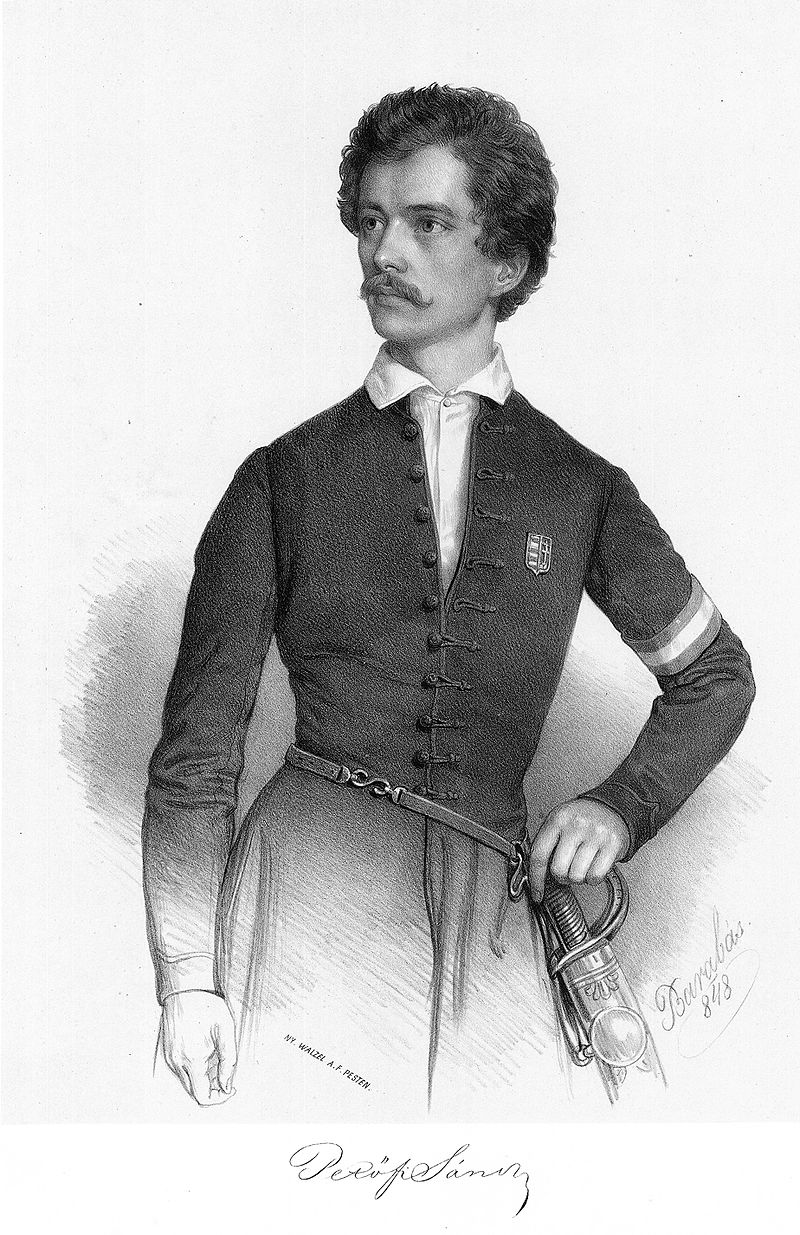
Miklós Barabás: Sándor Petőfi (1848)
As a single young man, the beginning of the 1840s brought a series of sublets to the poet's life, as Lajos Hatvany described him, during these years he was a "resident of monthly rooms" in Pest and moved from one sublet to another. He mainly rented accommodation along and around today's Inner Ring Road, which was still considered a suburb at the time but was close to the city.
However, love and marriage brought changes to Petőfi's life, which put his previous stay in the city into a different dimension. He went from subtenant to main tenant and wanted to exchange constant migration for permanent settlement. However, the low income prompted and forced the poet, who was now married and then had a family, to change places several times.
Even before the engagement, he asked his actor friend, Gábor Egressy, to get him a flat in the city. Egressy looked at at least fifty locations until he managed to select and secure the flat he thought was the most suitable for Petőfi and his wife. It was located on the upper part of the one-story Schiller House on Dohány Street, which was arranged for them by the actor's wife, Zsuzsanna Egressyné Szentpétery, and helped the newlyweds in their everyday life not only then, but also later.
After the honeymoon in Koltó, in the fall of 1847 Petőfi and Júlia Szendrey had no choice but to move into their new, now considered permanent, nest in Pest. But it was shared in another sense as well. Because Mór Jókai, who was also living in a sublet until then, also moved in with them, in this three-room flat on Dohány Street as a co-tenant, which was easier for the Petőfis in terms of paying the annual rent of 650 forints. Jókai lived in one room, the Petőfi and his wife in the other, and they shared the kitchen.
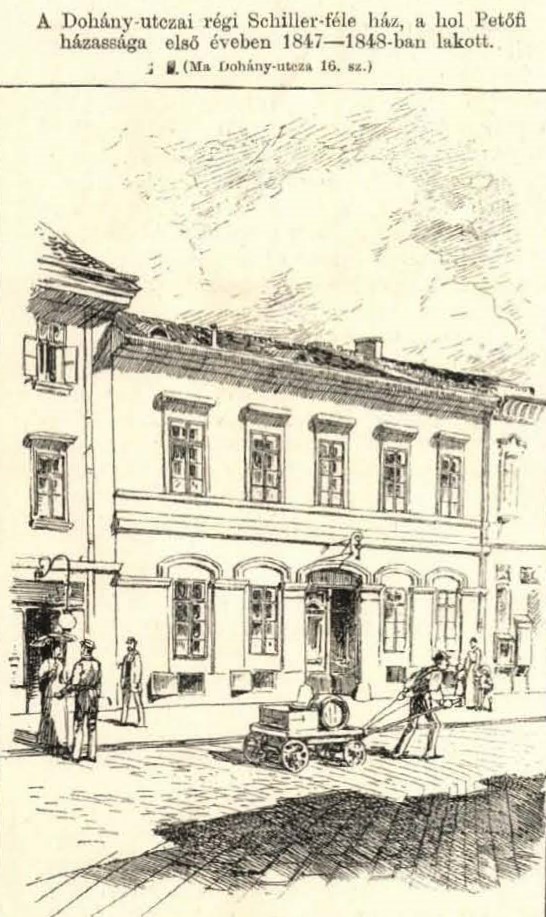
Petőfi's first flat as a main tenant was in the former Schiller House on Dohány Street (Source: Vasárnapi Ujság, 1 January 1893)
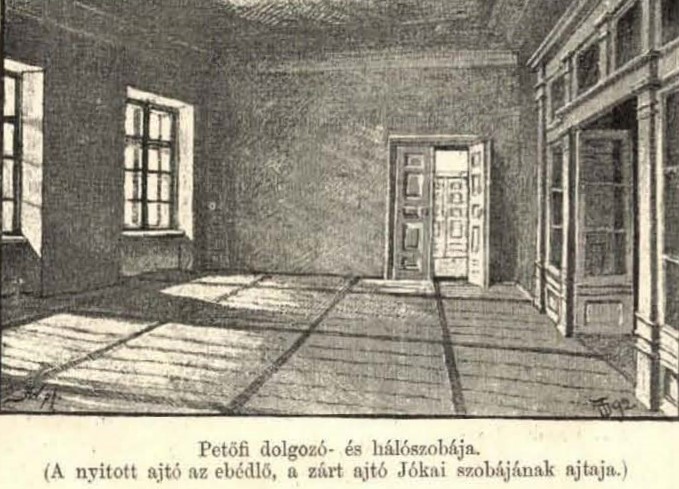
The flat shared with Mór Jókai in the Schiller House on Dohány Street (Source: Vasárnapi Ujság, 1 January 1893)
In 1904, a five-story metropolitan house was built on the site of the former one-story Schiller House at 16-18 Dohány Street. (Photo: Zsolt Dubniczky/pestbuda.hu)
Love, however, created deep tension and hostility in Petőfi and Jókai's friendship. Petőfi opposed and wanted to prevent Jókai's marriage to the celebrated actress of the time, Róza Laborfalvi. However, his endeavour was unsuccessful, and Jókai chose his love, the actress, instead of the friendship of the poet, and in June 1848 he moved out of the flat. Petőfi's parents, István Petrovics and Mária Hrúz brought up from Vác, moved into his place.
However, they could not cover the high rent on their own, so soon after Jókai's departure, they - along with Petőfi's parents - were forced to move to a cheaper and more modest flat in the one-story Szupp House on the corner of Lövész and Bástya Streets (today it is18 Királyi Pál Street), where they also rented a three-room flat. However, they no longer had the money to paint it, so - as they wrote in the recollection of Koszorú, published in 1884 - the flat's blank, old-painted wall was "in full harmony with their depressed financial situation".
In 1848, the Petőfi Family spent almost two months in the upstairs flat of a former one-story house located at 18 Királyi Pál Street (Photo: Zsolt Dubniczky/pestbuda.hu)
The plaque placed on the wall of today's house at 18 Királyi Pál Street also commemorates the Petőfi's stay here (Photo: Zsolt Dubniczky/pestbuda.hu)
At the end of August 1848, the political events in the country accelerated, and the legal, constitutional order achieved a few months earlier, and the independence of Hungary, were threatened. The ruler Franz Joseph threatened the country with a military attack, and on 11 September Jellasics led an army of 35,000 against Hungary and the Hungarian government. The fervour of the war of independence also captivated the Petőfi Family. Petőfi's 57-year-old father enlisted as a soldier from the flat of this house on the corner of Lövész and Bástya Streets - he was appointed the flag bearer of the Pest volunteers - and the poet himself also volunteered for military service. Thus, he and his pregnant wife spent only a month and a half in the house located at today's 18 Királyi Pál Street, from 1 August to 24 September. The poet then took Júlia to her father-in-law in Erdőd and moved her parents to a flat on Zöldkert (now Reáltanoda) Street, where the furniture of the flat was also transported.
Petőfi spent the winter away from Pest, in Debrecen and Transylvania, where he helped his parents with money, and he did not return to Pest until the following year, during the siege of Buda, on 9 May 1849. His father was already dead by then, and his mother lived in Erdősor, far from the city (in the vicinity of today's Benczúr Street). While the commander of Buda Castle, the imperial and royal Major General Hentzi, shot Pest with cannons, Petőfi anxiously hurried to his dying mother, who passed away shortly after the meeting.
The Petőfis' third and last main tenancy flat was in the Marczibányi House on the corner of today's Dohány and Síp Streets, not far from the former Schiller House, where they lived in the second-floor flat for only a few months, from May to 3 July. Built in the early 1810s, the building overlooking three streets (Dohány and Síp Streets, Kerepesi Road) was a residential house of the Marczibányi Family and an important source of income in Pest for them, which was specifically built for rental purposes. Gábor Egressy probably acquired the flat again, who also lived in this house at the time. And Petőfi recommended János Arany a flat in this house. Three of them lived in the apartment, consisting of two street rooms and one courtyard room overlooking Dohány Street: Petőfi and his wife, as well as their son Zoltán, who was born on 15 December 1848.
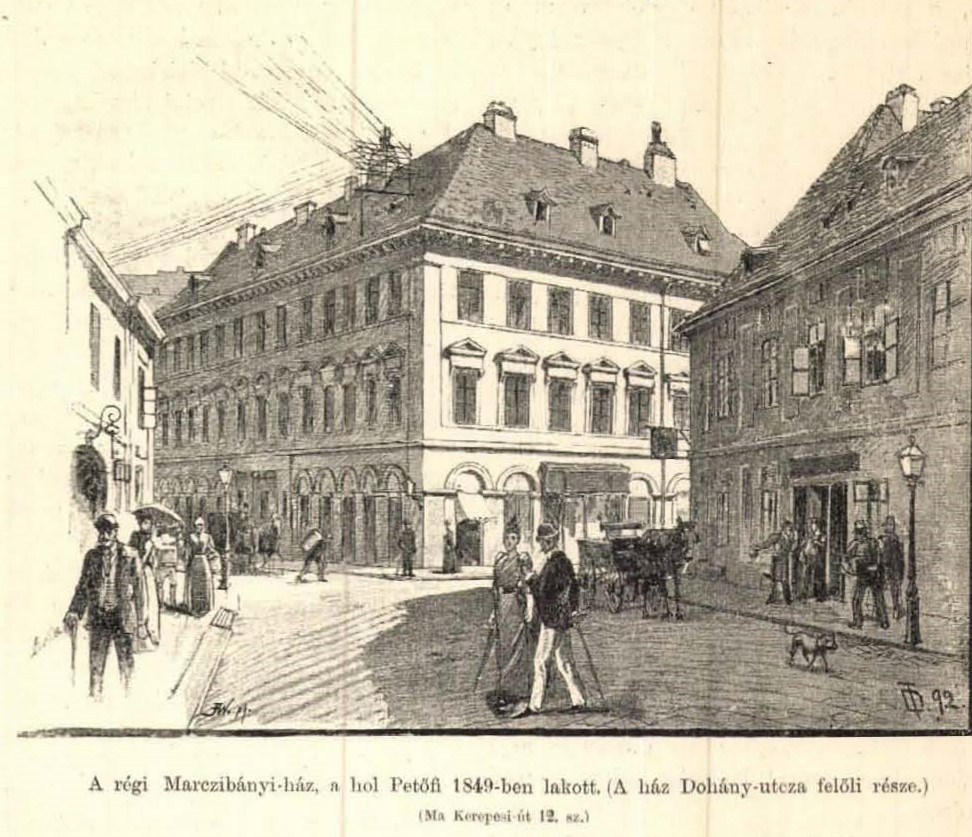
The Petőfi Family last lived in Pest on the second floor of the Dohány Street part of the former Marczibányi House on the corner of Dohány and Síp Streets, (Source: Vasárnapi Ujság, 1 January 1893)
In 1937, a multi-storey red brick house was built on the site of the former Marczibányi House (Photo: Zsolt Dubniczky/pestbuda.hu)
Petőfi usually walked up the stairs of the side stairwell at the back of the house, on Dohány Street, to their second-floor apartment, dressed as a military officer, where he and his wife often experienced the first difficulties and pitfalls of raising a child as young parents, and often turned to the help of Egressyné, who had more experience in raising children. It happened - Gábor Egressy's son Ákos writes in his reminiscences - that "...they completely forgot about Zoltán, who was fussing in the cradle. Only the noisy appearance of the child: his loud crying and wailing woke [them] from their daydreams.” It is no wonder since the former witnesses often saw Júlia Szendrey in the corridor rocking the cradle with one hand and holding a book and reading in the other.
The Petőfi Family stayed in this flat until 3 July, then left Pest and entrusted the keys to the flat to their neighbours, leaving behind a rent debt of 46 forints. The furniture of the apartment was later moved by the caretaker of the Marczibányi House to 7 Kerepesi (now Rákóczi) Road because the flat was rented out to new tenants. When the Austrian troops occupied Pest, they searched for the Petőfi Family's remaining goods and put them up for auction on 31 January 1850.
Of the three houses that included Petőfi's main tenancy flats, only one is standing today, the building at 18 Királyi Pál Street, which grew to three floors in 1871 (Photo: Zsolt Dubniczky/pestbuda.hu)
Of the three houses that included Petőfi's main tenancy flats, only one is standing today, the building at 18 Királyi Pál Street, which was expanded over time, along with the growth of the city. In 1871, two more floors were added to the former one-story house, built in 1839. On the site of the Schiller and Marczibányi Houses on Dohány Street, in the first third of the 20th century, new, metropolitan buildings were erected. Although it was not possible to preserve the Marczibányi House and the flat inside it, which was demolished in 1936, the photographs taken shortly before and the recording of the location, as well as the memorial plaque placed in 1937, ensure that the memory lives on.
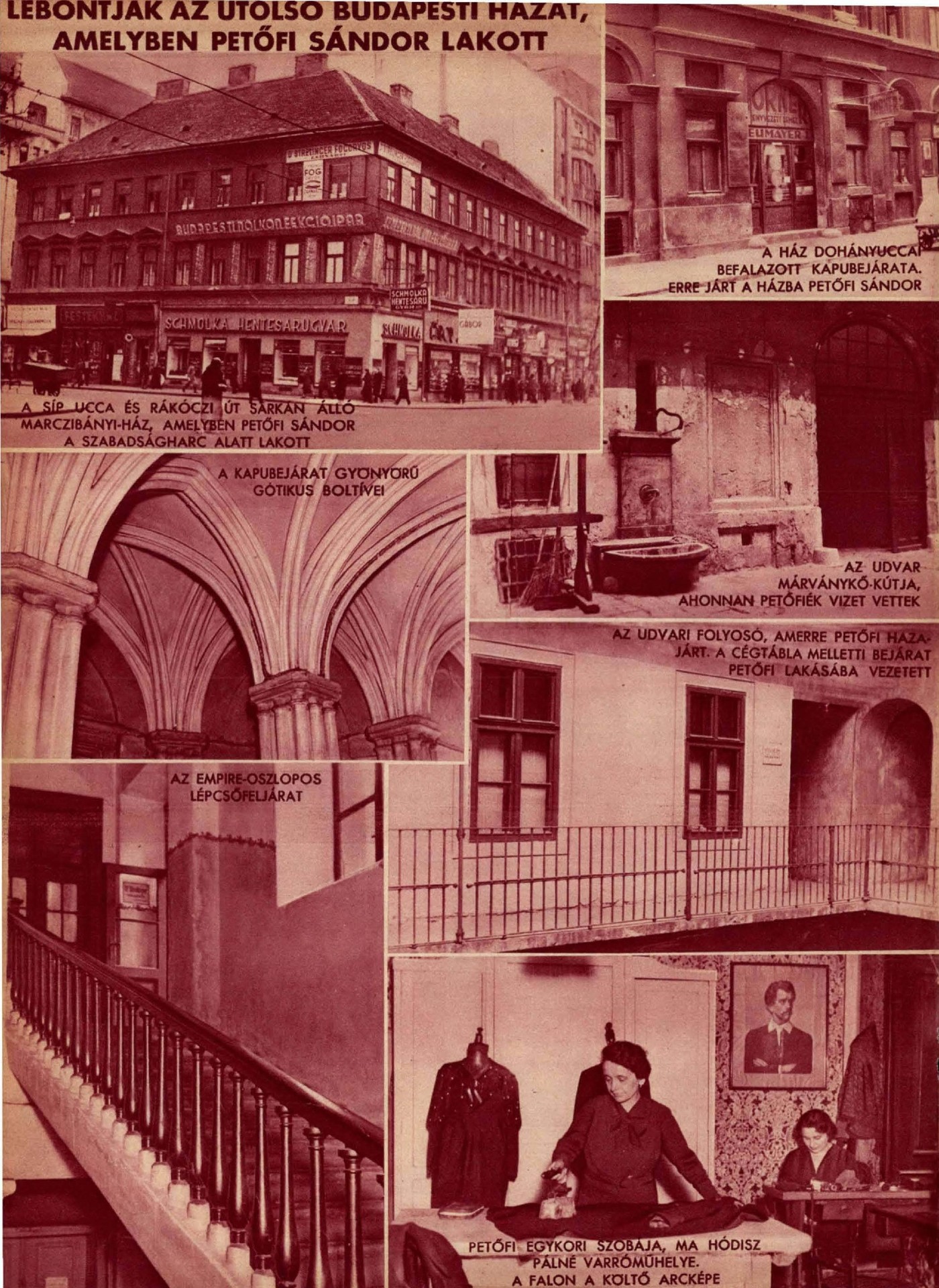
The Marczibányi House, together with Petőfi's flat, was demolished in 1936 (Source: Pesti Napló Képes Melléklete, 26 January 1936)
A plaque placed in the showcase of the red brick house built on the site of the former Marczibányi House at today's 12 Rákóczi Road commemorates Petőfi's last flat in Pest (Photo: Zsolt Dubniczky/pestbuda.hu)
Petőfi's relief on the plaque (Photo: Zsolt Dubniczky/pestbuda.hu)
Cover photo: Of the three houses that included Petőfi's main tenancy flats, only one is standing today, the building at 18 Királyi Pál Street, which grew to three floors in 1871 (Photo: Zsolt Dubniczky/pestbuda.hu)




































Hozzászólások
Log in or register to comment!
Login Registration